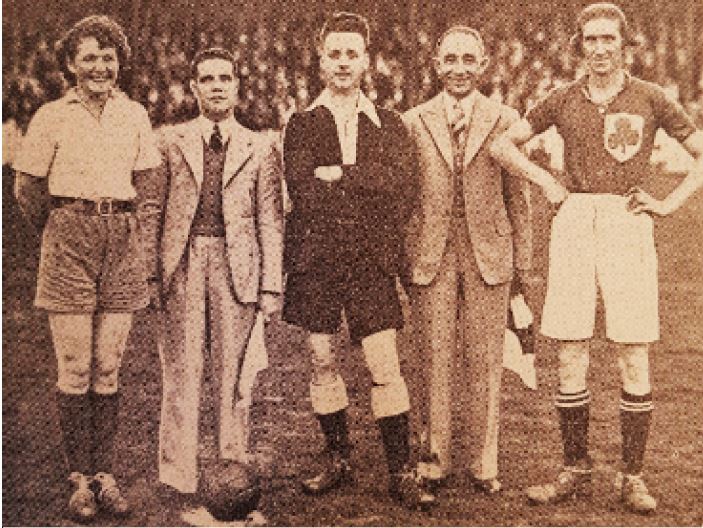
1936 Belfast. Grosvenor Park
Carmen Pomies (France), Molly Seaton (Ireland) plus Officials
(Source: British Newspaper Archive)
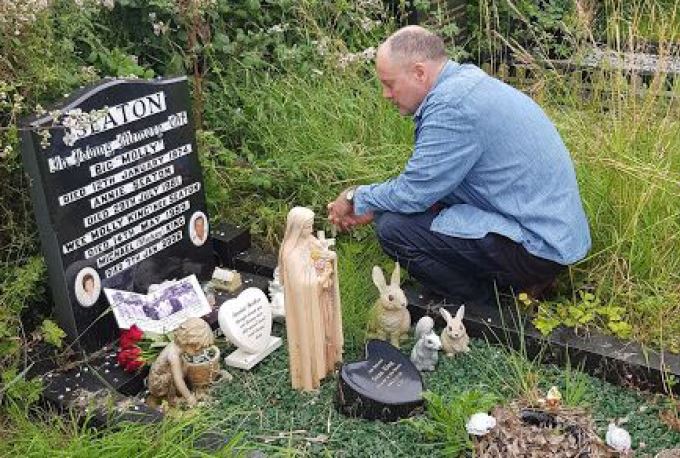
Molly’s Grave in Greencastle
(Source: Author’s collection)
Mary Ann Seaton aka ‘Big Molly’
Molly was born on 2nd September 1905 in Greencastle, Belfast. She passed away on 12th January 1974 at the age of 68 Years and 4 months. Her father Henry Seaton died in 1914 when she was just 9 years old and her mother Annie Jane died in 1951 when she was 46 years old. She lived on Dandy Street which is just off the Shore Road down by the Docks in Belfast. As a youngster she is reputed to have played for local men’s sides in the Whitehouse District – and she could hold her own. She formed her own local ladies team called Castle Rovers which played many charity matches at Seaview, the nearby Crusaders ground (Crues). She was reputed to have had her own agent called Joe Farrell, also known as Josie. Because of Big Molly’s crowd pulling displays, she was often included in the Ireland ladies’ newspaper advertisements. Belfast was renowned worldwide in the 1920s and 1930s for its linen. Molly worked as a doffing mistress at Whitehouse Flax Spinning mill and Upper Corgery Road spinning mill. A Doffing Mistress was a rather fierce character who would keep the younger women and men in order. Apparently she used to love waving a 10 shilling note at the male players after the game because they weren’t paid a penny. Molly never married. She did love a pint of guinness and like a lot of the women footballers of that era enjoyed a smoke. In later years she liked a pint in one of the local drinking establishments such as Morrison’s Bar or the Edinburgh Castle Bar.
NB. A lot of this information is taken from an edition of the North Belfast News in 1999 which ran an article entitled “Molly Seaton – Dandy St’s Answer to George Best” and from the oral memories witnessed in the Belfast Forum. What strikes me more than anything is the fondness with which she is remembered – a real character.
Football In Belfast
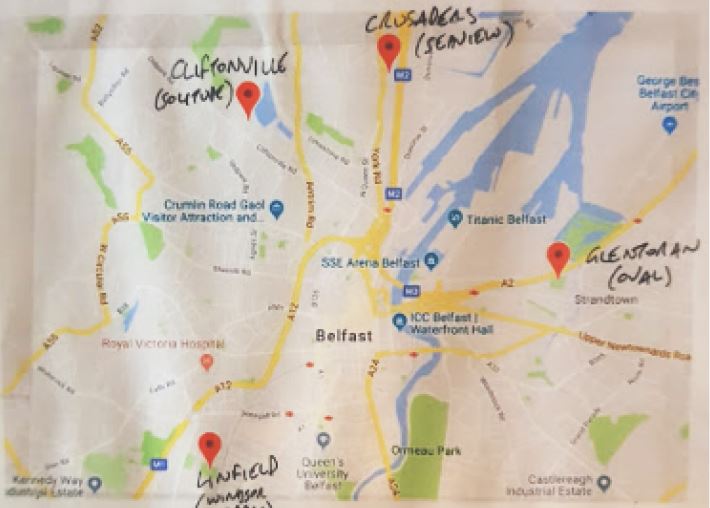
Windsor Park, Solitude, Seaview, Oval
A Pioneer in the Age of Prejudice
Women footballers have had to overcome tremendous obstacles to play the game they love over the last one hundred years or so. The fact is that women footballers today are regarded as pioneers, which they are, but sadly every generation of women footballers have had to be pioneers. This was especially so in the years following the December 5th, 1921 English FA ban whose pernicious influence went far beyond the borders of England and lasted far longer than its nasty 48 years. A lot of modern writers with little thought to the context and background write an awful lot of nonsense about the sexuality of the early women footballers. My own granny had a lifelong female ‘soulmate’, my Aunt Alice who became a ‘surrogate’ mother to my father and Uncle when their father died in 1949. It is very simple for me. My granny and Aunt Alice found comfort in their great ‘friendship’ and that for me is enough. I am glad. I wish other people would respect her great friend Lily Parr in the same way.
I am making no inferences here about Molly. What I have had to think long and hard about is the way that inarguably Molly presents as very, very masculine in looks and build. This cannot be ignored. If she were born now then who knows what procedures and support she would have had. However, she was born then as Mary Ann Seaton and that is how she lived her life. I know from some of the pithy comments on the Belfast Forum that she had to put up with any amount of ‘banter’ and ‘abuse’ and this must have happened for all of her life. What we can do today is praise her for her courage and determination in what she had to overcome to become such a successful and respected woman footballer. To go beyond that would be prurient and disrespectful. My aim is to celebrate Molly the footballer. I think Ireland should be very proud of her…
Molly the Footballer vs Molly the Legend
Molly is such an iconic personality, especially in and around Belfast that a number of myths and legends have been created. She is starting to match my granny’s mate Lily Parr in this manner. Here are a few clarifications.
Molly was 5 feet 10 ½ inches tall
Molly is described in many accounts as being ‘over 6 feet tall’. This is very similar to accounts which are equally incorrect that Lily Parr was over 6 feet tall. This is due to oral memory which is very unreliable. It doesn’t take much research to show that women of the day were much smaller than they are now. My granny was 5 foot 8 inches tall and I have numerous photos of her stood next to Lily and they are about the same height. Similarly, I would have judged Molly to be 5 foot 10 inches tall but then I was sent an article from 1927 in which her manager describes his new signing as being 5 foot 10 ½ inches. If you look at the first picture in this article my granny’s mate Carmen Pomies was 5 foot 8 inches tall.
Molly Seaton did NOT sign for Linfield
Sadie Smith, grandmother of Eddie Reader (of Fairground Attraction fame) did sign for Linfield, but did not play for them. I have found the article and picture from where I think this rumour originates. This was just a little advertising stunt and the original picture in the article shows Molly and Sadie at the signing.
Molly Was NEVER Banned For Life
I have found no evidence to support the contention that she was banned for life. She played well into the late 1930s and refereed games as well. I think that such a thing happening to such a high profile person would have been reported. She certainly did play a game of football which I think would make Roy Keane blush. In the 1936 game against the French one of Molly’s tackles caused the French Captain Carmen Pomies to march off the entire French team and they had to be persuaded back on by Alfred Frankland. I would also make the point that there wasn’t any official body who could ban her!
1921 and the Infamous FA Ban
1921 was the ‘golden year’ of women’s football. Modern women’s football (as we would recognise it today) started directly thanks to the First World War. However, despite some early games most of the intense football wasn’t until the 1917-1918 and 1918-1919 seasons. The golden ‘war’ season was 1917-1918 as by the end of 1918 and the start of 1919 the allies were winning the war, huge and abrupt layoffs of women workers were happening and priorities were changing. By 1920 it had began to be realised that even if we had ‘won’ the war we still hadn’t ‘won’ the peace and there was an incredible amount of unemployment, hardship, injury, mental illness and ill-health without the infrastructure to cope. Women’s football really started to take off again in 1920 and by 1921 the statistics in England are incredible. There hardly seems to be a blade of grass in the country that didn’t have some form of women’s football taking place. By December 5th 1921 the English FA had had enough and they banned all women’s football from affiliated FA grounds. This included male referees and players helping out and it wasn’t rescinded (reluctantly)
until 1969. Scotland followed suit shortly afterwards and Wales blew hot and cold over the years. The one part of the United Kingdom that wasn’t affected was Northern Ireland.
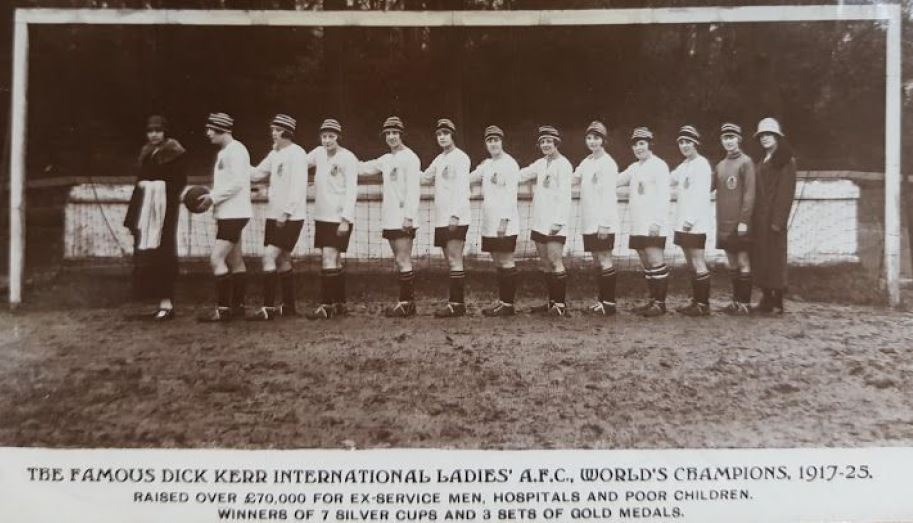
World Champions – Lily holding ball, Lizzy next and the rest of the gang
(Source: Author’s collection)
However, the legendary Dick Kerr Ladies did not always have it their own way and in 1923 they were outmaneuvered by the clever managerial skills of J H Kelly.
1923 ~ Rutherglen Ladies FC
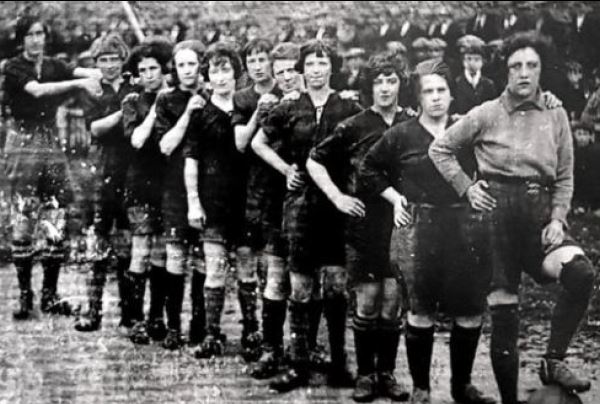
‘Irish’ Team in 1927 (J H Kelly Touring Team) – Molly on the left
(Source: Bigger McDonald Collection)
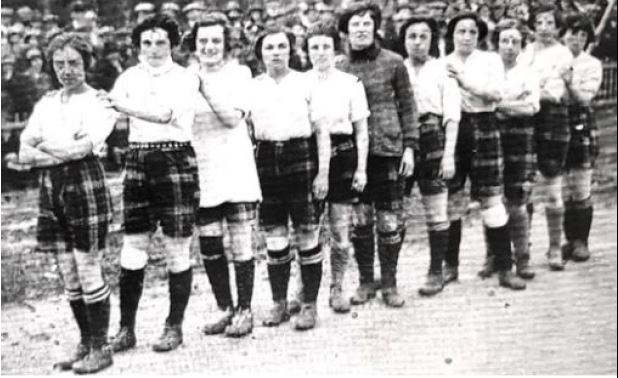
Scottish Team in 1927 (J H Kelly Touring Team)
(Source: Bigger McDonald Collection)
In September 1923 a Glaswegian Factory Owner who ran a ladies football team felt confident enough to challenge the ‘World Champion’ Dick Kerr Ladies to a game in Glasgow. J H Kelly’s Rutherglen (industrial district of Glasgow) defeated the Dick Kerr Ladies by 2 goals to 0. Rutherglen then spent the next 10 years describing themselves as the World Champions because they had defeated the Dick Kerr Ladies. Ever wanting to strengthen his side J H Kelly signed on the magnificent Molly Seaton in 1927.
1925 ~ French Legends Tour
Carmen Pomies and Madeleine Bracquemond at Windsor Park
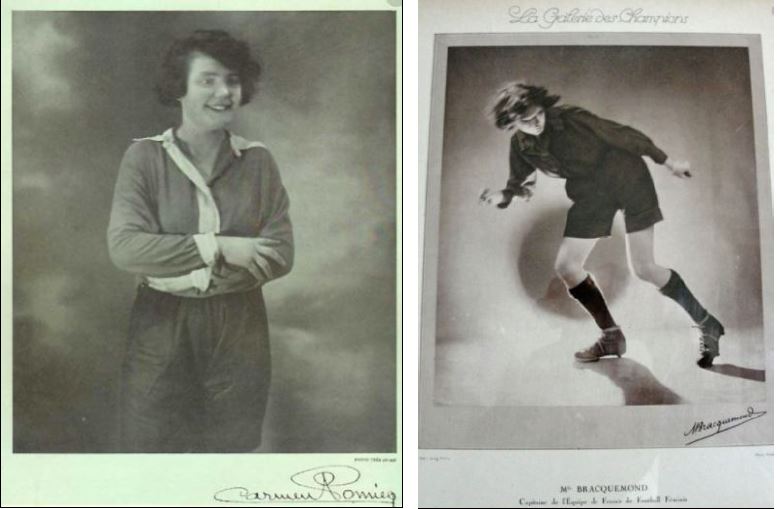
Carmen Pomies and Madeleine Bracquemond (Tres Sport Magazine ‘Champion’)
(Source: Author’s collection)
In 1925 these islands were privileged to have the two greatest French women footballers in history tour together. Carmen Pomies was to visit many times again before she became a resistance hero during the war. Madeleine Bracquemond popped over to Preston for a weekend with her new husband in 1931 but they never toured together again. At one point in and around the Paris region there were over 18 sides. Femina Sport had their own Stadium, Stade Elisabeth and a strong DKL side was put together for a high profile series of (hopefully) money-spinning games. Games were played at Herne Hill, Padiham, Mellor, Fallowfield, Hyde, Kilmarnock, Dumfries, Belfast, Chorley and finally a last match at Herne Hill. The DKL won 7, drew 2 and lost one.
The Pomies family were Parisian ‘A’ list. Brother George Pomies was a famous dancer and film star. He starred in two Jean Renoir films but died at the tragically young age of 31 in 1933. Sister Helene was a socialist author who wrote a number of books including one called ‘Blood in the Mountains’ about the resistance during WW2.
Madeleine Bracquemond was from her debut in 1918 until WW2 the superstar of French Football. She made a film in 1929 about women in sport where she was filmed taking part in a whole variety of sports. She was still Captain of France in 1935 when my granny led the Dick Kerr Ladies on only their second tour ever to the Continent.
1925 ~ International Women’s Football at Windsor Park
England (Dick Kerr Ladies) 2 v 0 France (Femina Sport)
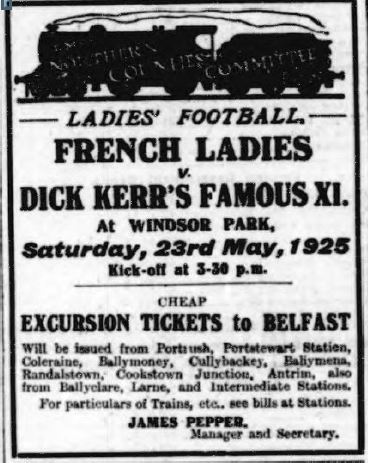
(Source: British Newspaper Archive)
On Saturday 23rd May 1925 a large crowd raised £450 for the Royal Victoria Hospital, Mater Infirmorium Hospital, Ulster Hospital for Women and Children and Shipwrecked Mariner’s Society. A large crowd saw one of the greatest French Women’s football teams lose 2 – 0 to one of the great incarnations of the Dick Kerr Ladies. Captain and legendary centre forward Florrie Redford scored a ‘fine goal from a difficult angle’. Lily Parr scored a penalty in the second half. My granny (described as the ‘best defender since Alice Kell’) helped keep out the French attack and perhaps the original women’s WW1 superstar Jenny Harris played as well.
Both teams were received by the Lord Mayor and given the usual five star treatment.
1927 ~ Rutherglen Signs Molly
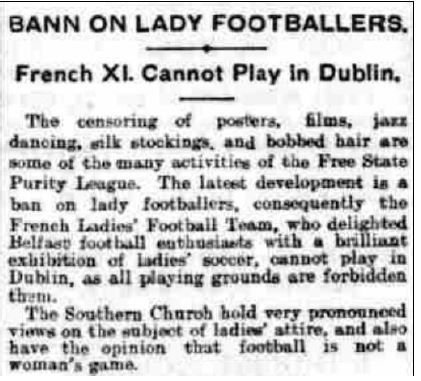
A NI paper giving views on the Free State
(Source: British Newspaper Archive)
One has to understand that after the FA ban one of the big problems of women’s football once you had gone to all the time and expense of setting up a team was – who to play? Famously, the Manchester Corinthians ran ‘two’ teams – Corinthians and Nomads, and later even a third team. Rutherglen and the Dick Kerr Ladies did this, but not as explicitly. In 1927, J H Kelly took a tour to Ireland which played matches variously billed as: Rutherglen vs Edinburgh and Ireland vs Scotland. They played in Belfast at Windsor Park and Gibson Park, Larne, Carrickfergus, Ballymena, Derry and Portadown. However, perhaps the most significant game was in Dublin.
On Wednesday 25th May an absolutely unique game was played at Milltown, Dublin. This is the home of Shamrock Rovers. The game was billed as Scotland (Rutherglen) vs Ireland (Dublin). The score is reported as 8 or 9 versus 1 in favour of the Scots. There was a remarkable crowd of 12,000. I have only uncovered two greater crowds (both 15,000) after the FA ban. Miss Clarke scored the Irish goal. Molly is reputed to have scored several of the Scottish goals.
In 1928 a similar tour took place which played only in Northern Ireland. Molly led the ‘Irish’ team and is described as the star player. They played in Larne, Ballymena, Derry and Belfast (Edenderry). They were advertised to play at the Brandywell Ground on Saturday 8 September but as of yet no details have emerged. Often, prior to the games there would be a 100 yards sprinting contest between Molly and Sadie Smith. Sadie’s granddaughter is Glaswegian singer Eddie Reader who remembers her footballing granny fondly.
1931 & 1932 ~ Belfast Linen Girls
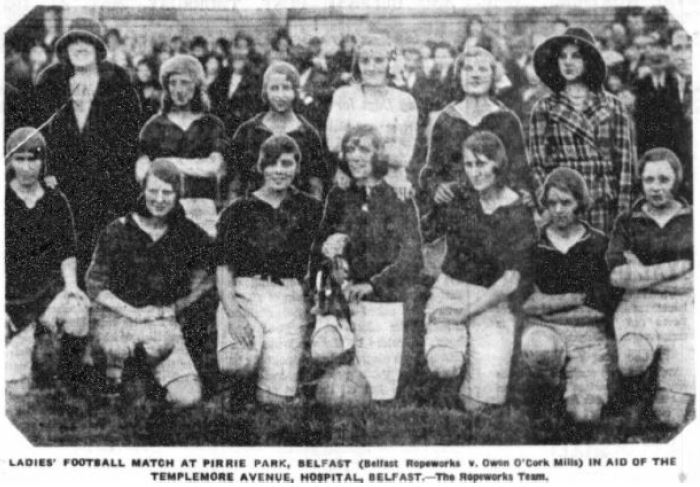
12,000 Spectators watched Ropeworks defeat Owen O’Cork 2-0 at Pirrie Park
Miss Annie Boyle, newly elected ‘May Queen’ is seen in the top right!
(Source: British Newspaper Archive)
England, Scotland and Wales enjoyed a renaissance of women’s football in the 1930s. This increase was really only interrupted by the storm clouds of World War Two. (Unfortunately it never really recovered…) Things are slightly more complicated in Northern Ireland. High profile matches did take place later on but the region enjoyed two ‘golden’ seasons in 1931 and 1932.
The local leading teams of that era were all associated with the world famous Belfast linen factories: Ropeworks, York Street Mill, Owen O’Corks, Jennymount Mill, Milewater Mill, Linfield Factory, Bangor Ladies and Bloomfield. The star player and leading light in all of this was the legendary Molly Seaton.
Games were played at Windsor Park, The Oval, Seaview, Pirrie Park, Ibrox Park, Ballyhome Showgrounds, Flixton Park, Comber Football Ground because the English FA ban did not affect this region. Seismic local political and social changes impacted on this amazing development of women’s football by 1933. Unfortunately I cannot do justice to this important and fascinating story in this short homage to Molly.
1931 ~ Isle Of Man
York Street 3 v 3 Ropeworks
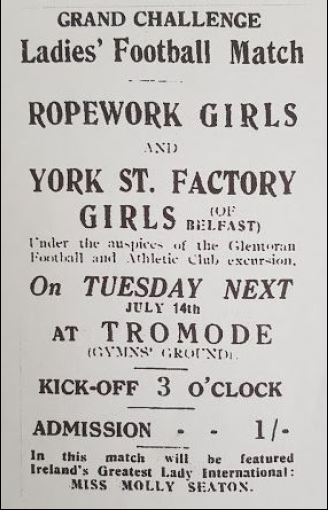
(Source: Isle of Man Newspaper Archive)
Molly was described in one article in the Isle of Man Examiner as having played in ladies soccer matches between ‘Northern Ireland and the Free State’ and the Dick Kerr Ladies. The article goes on to state: “From the very kick-off – and all through the game – Miss Seaton was the one player whose performance commanded attention. Her knowledge of the practical points of the game was astonishing, and there are many players in the Isle of Man who probably wish they had her stamina and ability.”
This day trip from Belfast was sponsored by Glentoran Football Club. The 1,000 ‘excursionists’ from Belfast had a ticket to the football match included in their trip. They set off on ‘Mona’s Isle’ at 9.15am and reached Douglas 5 hours later. En route the Kitchenor Prize Pipe Band accompanied them. The GW Wolfe Memorial Band accompanied them from the Pier to Tromode and played before the game and at half-time.
The game was played at Tromode Park which was the home ground of Gymnasium AFC. In a keenly contested game on a hot sunny day Ropeworks were described as the better team (having won two previous encounters) but Molly Seaton stood between them and a runaway victory. Valerie Beattie (Larne Resident) and daughter of York Street Player Betsy Briton has been in touch. She tells me that the women were all given a horseshoe and a bolt of linen as mementoes. She still has the horseshoe in her shop window to this day. Valerie also has some wonderful anecdotes from her mother about Molly. Apparently, there was a very small player on the opposing team and occasionally Molly would stand with her legs apart and the other player would dribble through
1931 ~ Molly Meets the Dick Kerr Ladies
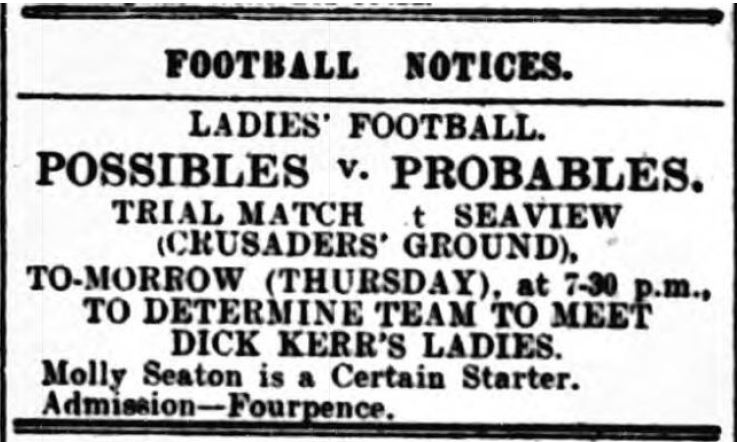
Preparation Match for Playing the Dick Kerr Ladies
(Source: British Newspaper Archive)
It is worth noting that the there was a trial match to prepare for the big game against the superstars of the Dick Kerr Ladies. Even the trial game was played at Seaview which was the Crusaders Ground. Molly is advertised as a draw for the crowds.
In 1931 the Dick Kerr Ladies team is described as being of average age 20, height 5 feet 5 ½ inches and weight 8 ½ stone. Women were much, much smaller in those days than they are now. The Dick Kerr Ladies were regarded as a ‘bunch of bruisers’ compared to other women’s football teams.
In another article the French team is described as being of average height of 5 feet 1 ½ inches tall.
I will emphasise again: women of that era were a lot shorter than they are today.
Windsor Park – Molly Scores 2
1931 England (Dick Kerr Ladies) 3 v 2 Ireland
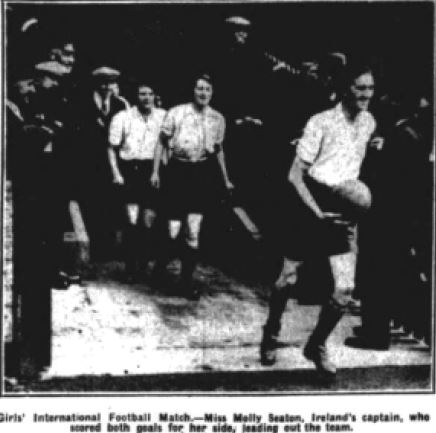
(Source: British Newspaper Archive)
On Monday 27 July at 7.15pm at Windsor Park in front of a crowd of 4,500 my granny played for the Dick Kerr Ladies against the Irish side led by Molly Seaton. The teams that day were:
‘Ireland ’ – Sleator (York St), Cree (Owen O’Cork), Donaldson (Ropeworks), Herbert (Ropeworks), Molly
Seaton (Cap) (York St), M’Kelvey (Owen O’Cork), Morris (Ropeworks), Kearney (York St), Hines
(Ropeworks), Smyth (Ropeworks), Gibson (Ropeworks)
‘England’ – Maggie Shaw, C Howarth, Lizzy Ashcroft (my granny!), Lily Buxton, Edith Hutton, A Marsh,
Lydia Ackers, Jenny Harris, Hilda Parkinson, Susie Chorley and Lily Parr
There is a wonderful article in the Belfast Newspaper the Northern Whig which completely eulogises Molly Seaton. It goes on to say that in a keenly contested game the DKL were to have played against Ireland but instead played against Molly Seaton. The article talks about ‘penny dreadfuls’ where the boy from the mining village triumphs in the FA Cup Final and describes Molly Seaton as the nearest to this incarnation it is possible to see. Three ‘strapping Englishwomen’ (I hope he doesn’t mean my granny!) shadowed Molly at every move. They tried to sandwich her, to bamboozle her with three-cornered short passing, to kick the ball over her head, to charge her, and to dribble past her, but she got the ball almost every time. The article goes on. Eventually despite Molly’s two valiant goals the DKL won with two Lily Parr goals and a Susie Chorley winner.
1932 ~ Two close games with France
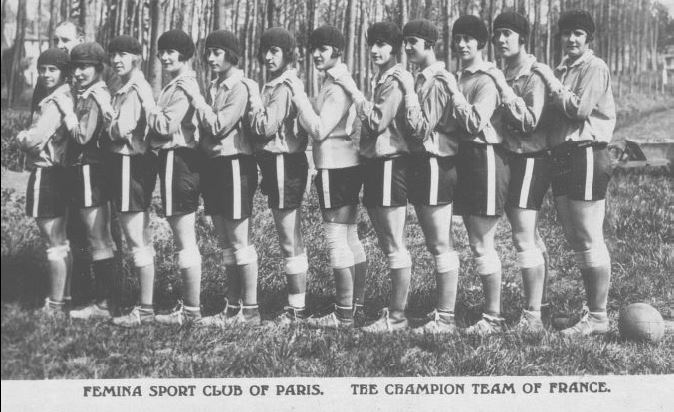
Femina Sport – Madeleine Bracquemond (4th left), Carmen Pomies (Right)
(Source: Author’s collection)
In 1932 Dick Kerr Ladies manager Alfred Frankland was ‘getting the show back on the road’. In their first tour since 1925 Femina Sport arrived for a short 4 game tour. The now married Madeleine Bracquemond did not tour and the tour was led by Carmen Pomies. The remarkable Carmen Pomies was not only the star player but she was also the tour manager and organiser. Even more remarkably, she and Alfred Frankland ‘franchised’ the French team to play two of the games in Northern Ireland. Alfred Frankland accompanied the team and he would always take two of his favourite ‘lieutenants’ with him. In this case it was the DKL Vice-Captain Lizzy Ashcroft and the young star Margaret Thornborough.
Thurs 4th August Ireland 3 v 4 Femina Grosvenor Park, Belfast
Fri 5th August Ireland 1 v 0 France Ballyhome Showgrounds, Bangor
1932 ~ Ireland 3 v 4 France Grosvenor Park
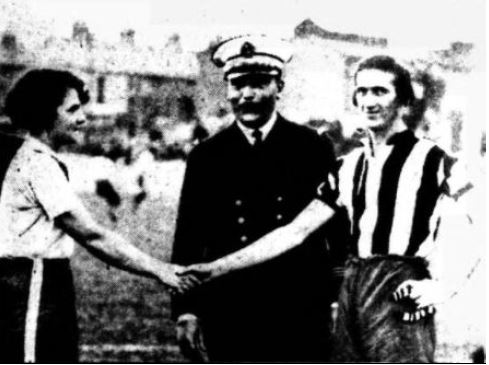
Carmen Pomies, Lt Bertrand Gelli, Molly Seaton
(Source: British Newspaper Archive)
The French team arrived early in the morning via the Heysham-Belfast Ferry. It is perhaps worth saying that the arrival of 20 or so glamorous FRENCH women footballers caused quite a stir, as it did in Northern England in the 1930s. Life was tough for many working class people and the French ladies tended to be upper middle class and dressed in the latest Paris Fashions. They were quite voluble, confident and festooned everything around them with tricolours. Gail Newsham describes their arrival in Preston as being like ‘aliens had landed’. It also happens that as part of a Naval exercise there were four French Navy Frigates moored in Belfast Harbour for an organised visit. The women were taken on a tour of the harbour and the boats and the French sailors were all given leave to go to the match. Remarkably, I have a photo in my collection of my granny and some of the French team on board the L’Oise which was the flagship boat commanded by Lieutenant Bertrand Gelli of the French Navy.
Belfast football legends Mick Hamill refereed and Joe Bambrick and Fred Roberts ran the line. Lieutenant Gelli kicked off. The game was privileged with the appearance of another legend of French football the vice-Captain Solange Manca. Solange Manca later caused absolute shock the following year to a Yorkshire football reporter because she was married, had a child and was playing football without a husband in tow – absolute astonishment…
This was I believe a record breaking game. After the 1921 ban I am only aware of one other pre-WW2 game with a credible crowd of 15,000. (Wales – June 1933 DKL vs Lovells in Tredegar). The atmosphere must have been amazing with the large French contingent in the crowd. The game is described as ‘keenly’ contested. Carmen Pomies went off at half-time and did not play the next day. Miss Rice had to retire hurt for Ireland. Molly Seaton was again heavily ‘shadowed’ especially in the second half and she stayed overnight in the Royal Victoria Hospital. The scorers were for France: Pomies, Darreau, Behr, Goinard and for Ireland: Kearney, Seaton, Rice.
1932 ~ Ireland Beat France by 1 goal to Nil
The second game of the tour was ‘even more’ keenly contested. Notable absentees were Carmen Pomies and Molly Seaton. Miss Gladys Gordon who was deputising for the absent Molly at centre half caused much excitement when she scored the only goal of the game in the first half. The goalkeeper Miss Collins and the right back Miss Conway are singled out for praise for keeping out the superior skilled French side. Mickey Hamill again refereed and Fred Roberts of Glentoran and J B Stark ran the lines. £100 was raised for the men’s Bangor FC team! The Ballymena Observer concedes that ‘both elevens were quite at home on the football pitch’. It also goes on to say that ‘pugilism was not entirely absent’ and it describes Mickey Hamill as being a ‘brave man’ for separating the combatants.
The French team were given a Mayoral Reception and entertained to lunch at the Royal Hotel in Bangor. The multi-lingual Carmen Pomies gave her usual polished speech and Alfred Frankland also spoke. Mr Jacob O’Neill arranged a motor-bus tour of the TT course and a run through the scenic Ards Peninsula. The sports manager of Bangor organised a diving display at Pickie bathing place. They were then given tea at the Regent Palace Hotel as guests of Bangor FC.
1932 ~ Irish Ladies Football Cup
Molly Seaton XI 5 v 0 Ropeworks
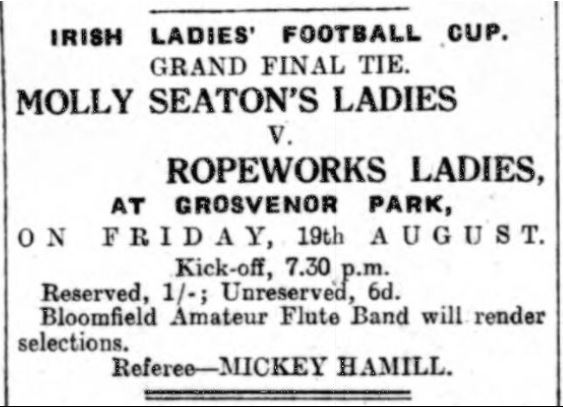
Advert for the Irish Ladies Football Cup
(Source: British Newspaper Archive)
The teams were:
Molly Seaton XI – Collins, Clarke, Betsy Briton, Nelson, Molly Seaton, Morris, McLouglin, B Clarke, Kearney, Mawhinney, Bradley
Ropeworks – Davis, Anderson, Donaldson, Hume, McKelvey, Magee, Torrens, Smith, Thompson, Rice,
Gibson
Molly Seaton’s team were described as being superior in control and marksmanship right from the start. However, they were only 1-0 up at half-time. Molly is described as being the driving force behind her team. The scorers were Bradley, Kearney (2) and inevitably Molly with 2. The Ropeworks team were commended for never giving up and a large crowd watched an enjoyable if one-sided game.
Mr A Shepherd presented the silver cup to Molly. He thanked the Distillery Club Directors for the use of the ground and Mickey Hamill for refereeing. It is worth noting the Molly ‘suitably’ responded.
It is also interesting to note that at least one newspaper report promised that the game would be over by 8.40pm so that spectators could catch special buses to be on the TT course by before 9pm.
I must remember to tell Valerie Beattie that her mother Betsy Briton won the one and only ‘Irish Ladies Football Cup’.
1936 ~ No Prisoner’s Taken!
Ireland 1 v 4 France Grosvenor Park “Football of which no Irish League team need have been ashamed”
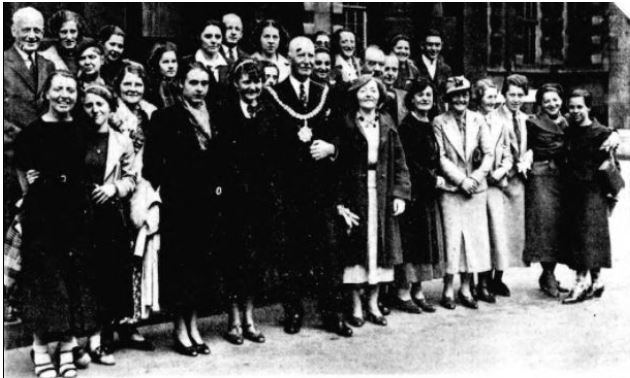
French Team posing with Lord Mayor at Rear of City Hall, Belfast
Carmen Pomies and Miss Winnifred McKenna next to the Mayor
(Source: British Newspaper Archive)
2,000 spectators watched an astonishing game with the Northern Whig reporting: “It was a feast of fun from beginning to end, with free fights intermingled with football of which no Irish League team need be ashamed” . Infact after one Molly Seaton challenge just before half-time Carmen Pomies marched her team off and only some swift diplomacy from Alfred Frankland persuaded them back on. The match was refereed by T Pendleton and the lines were run by Jimmy Warnock (Irish fly-weight boxing champion) and Billy McCleery (legendary footballer and cricketer). At half-time Mr Pendleton entered the dressing room (different times!) and addressed both teams who apparently were mixing freely and happily. They were admonished that unless: “tempers were toned down, hands cut out, and feet only used for legitimate purposes” he would have to adopt drastic measures. Despite this the paper goes on to say that in the second half there were a couple of incidents that would have drawn marching orders in a male Irish league game. One of the Irish girls had to sit out for 10 mins following a kick on the shins but to quote:
“The French girl who was responsible did not get off entirely scot-free, and unless the double cushions are unusually soft she is not likely to sit long on the boat going back.”
The French girls were worthy winners but sportingly agreed that the scoreline flattered with two of the goals being attributed to the shortness of the Irish goalkeeper. Once again, Molly was a tour de force on her own. Apparently the teams were all best of friends after the games. Astonishing…
On this particular tour the French team were taken to visit Stormont and then were received by the Lord Mayor at City Hall. They were taken on a visit to the Gallagher’s Tobacco Factory in the afternoon before the game.
Regular games probably took place until the start of World War 2. However this was the last really high profile game. Molly also pops up refereeing the odd game and she is also mentioned as a football scout.
Windsor Park ~ A Very Special Place

Author: Touching the Hallowed Turf at Windsor Park
(Source: Author’s collection)
In 1921 as a footballer for St Helens my granny was able to play at St Andrews (Birmingham), Hanley (Port Vale), Hawthorns (West Brom), Molineux twice (Wolves) but when she had her 13 year career with the Dick Kerr Ladies from 1923 to 1935 she rarely got the chance to play in the big ‘male’ football arenas, apart from a few Scottish ones.
However, she was able to play on the hallowed turf of Windsor Park twice. This was in 1925 for England (DKL) vs France (Femina Sport) and in 1931 for England (DKL) vs Ireland against the legendary Molly Seaton. It was therefore a very emotional moment for me to visit Windsor Park.
My main thanks of course to the indomitable Gail Newsham without whom the true story of the Dick Kerr Ladies would have been lost in the mists of time.
It is not for me as an Englishman to tell the people of Northern Ireland what to do with their football heritage. It is my view that Molly Seaton was every bit as good a footballer as my granny’s mate Lily Parr. She was kind, generous and very well regarded. She was also one heck of a footballer. I have 45 ringbinders of research and I have not seen such command of football games by one woman. As I have alluded to earlier she had many obstacles to overcome, more I would say than almost any women footballer that I can think of. We now have the Lily Parr Statue and in 2021 (100 year anniversary of the FA Ban) we will have the Lily Parr gallery at the National Football Museum. I do therefore lay down the challenge to do something in her honour. If and when this happens it will have my full support.
Article © of Steve Bolton

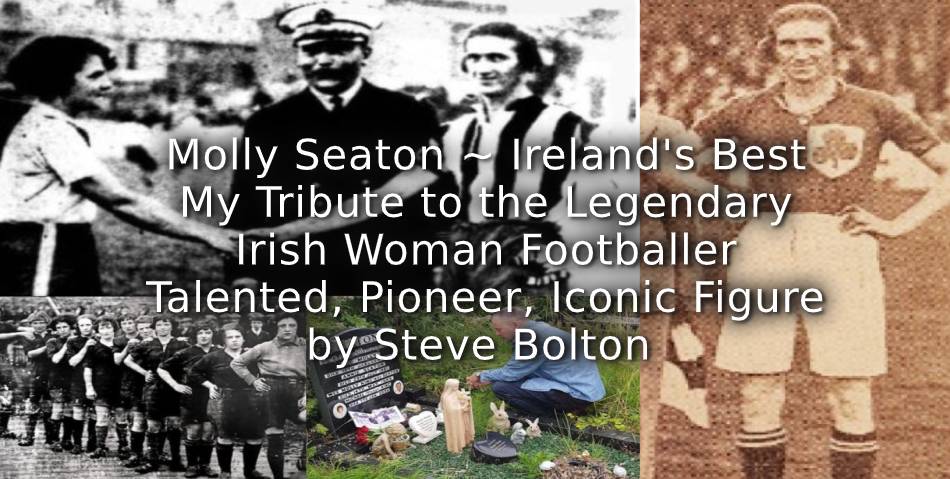
![“And then we were Boycotted”<br>New Discoveries about the Birth of Women’s Football in Italy [1933] <br> Part 9](https://www.playingpasts.co.uk/wp-content/uploads/2020/12/Boycotted-part-9-Marco-440x264.jpg)
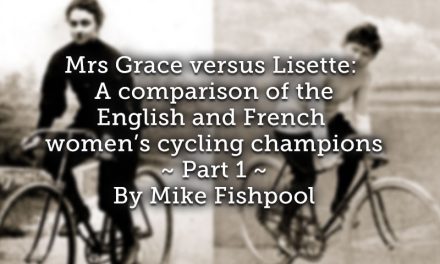
![I, Tonya, Cultural Capital and the American Dream [Spoiler Alert]](https://www.playingpasts.co.uk/wp-content/uploads/2018/02/tonyabanner-440x264.jpg)

Trackbacks/Pingbacks